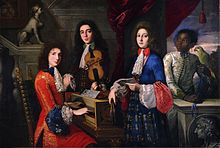Ferdinando de 'Medici (1663-1713)
Ferdinando de 'Medici (born August 9, 1663 in Florence ; † October 31, 1713 there ) was the eldest son of Grand Duke Cosimo III. de 'Medici and by Marguerite Louise d'Orléans and from 1670 to 1713 Hereditary Prince of Tuscany, but died before his father and remained without descendants.
Life
Ferdinando de 'Medici was Hereditary Prince of Tuscany from the time his father ascended the throne on May 23, 1670 , but never came to power because his father outlived him. Ferdinando was a great patron of the arts, especially music.

When his parents separated in 1675, Ferdinando's mother returned to Paris, and Ferdinando was placed under the care of his grandmother Vittoria della Rovere . Ferdinando was a brilliant rider and highly talented musician, played the harpsichord excellently and studied counterpoint with Gianmaria Paliardi and various stringed instruments with Piero Salvetti. His love affairs often involved men, such as the musician Petrillo or the Venetian castrato Francesco de Castris called "Cecchino". On the other hand, the once famous soprano Vittoria Tarquini was his lover.
Her marriage to Violante Beatrix von Bayern in 1689 remained childless. It is believed that Ferdinando contracted syphilis in 1696 during the Venice Carnival. His annual opera productions, which he began in 1679, ended in 1710 in the Medici Villa in Pratolino .
After the death of his father, Ferdinando's younger brother Gian Gastone took over the government, but he too died childless.
The musicians sponsored by Ferdinando included Alessandro and Domenico Scarlatti, Georg Friedrich Händel , Giacomo Antonio Perti , Giovanni L Limani , Giovanni Maria Pagliardi , Carlo Francesco Pollarolo , Giuseppe Maria Orlandini , Benedetto Marcello and Bernardo Pasquini . In 1701 Tomaso Albinoni dedicated his Op. 3 balletti a tre ; In 1711 Antonio Vivaldi dedicated L'Estro Armonico (Op. 3) to him. In 1688 Ferdinando Bartolomeo employed Cristofori as curator of his instrument collection. In Ferdinando's service, Cristofori invented the spinettone and the pianoforte , the forerunners of today's piano.
The painter Anton Domenico Gabbiani created a whole series of paintings with musicians, instrumentalists and castrato singers at Ferdinando's court.
literature
- Harold Acton : Gli ultimi Medici. Einaudi, Turin 1962.
- Mario Fabbri: Alessandro Scarlatti e il Principe Ferdinando de 'Medici (= Historiae Musicae Cultores. 16, ISSN 0073-2516 ). Olschki, Florence 1961.
- Christopher Hogwood : Georg Friedrich Handel. Translated from the English by Bettina Obrecht . Metzler, Stuttgart 1992, ISBN 3-476-00851-7 .
Web links
Individual evidence
- ↑ This information is provided by an Italian website and the French website Quell'Usignolo, which specializes in baroque singers (accessed January 4, 2020)
- ↑ Eleanor Selfridge-Field: A New Chronology of Venetian Opera and Related Genres, 1660-1760 , Stanford University Press, 2007, pp. 184-185 and footnote 314, online as a Google Book (English; accessed October 26, 2019)
- ↑ Vittoria Tarquini dite la Bombace , online at Quell'usignolo (French; accessed October 27, 2019)
| personal data | |
|---|---|
| SURNAME | Medici, Ferdinando de ' |
| BRIEF DESCRIPTION | elder son of Grand Duke Cosimo III. de 'Medici and Marguerite Louise d'Orléans |
| DATE OF BIRTH | August 9, 1663 |
| PLACE OF BIRTH | Florence |
| DATE OF DEATH | October 31, 1713 |
| Place of death | Florence |

